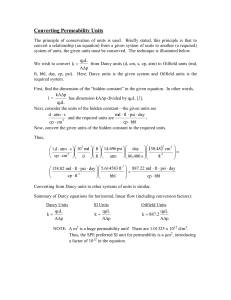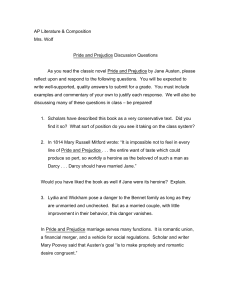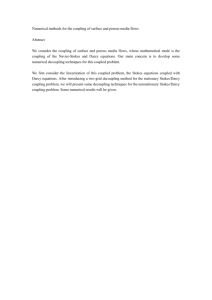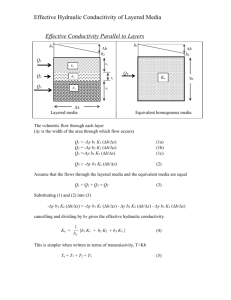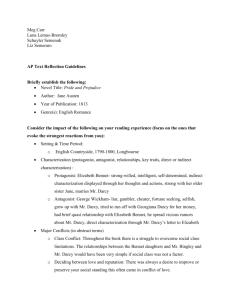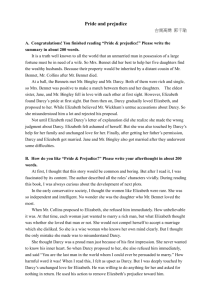Hydrodynamics in Porous Media
advertisement
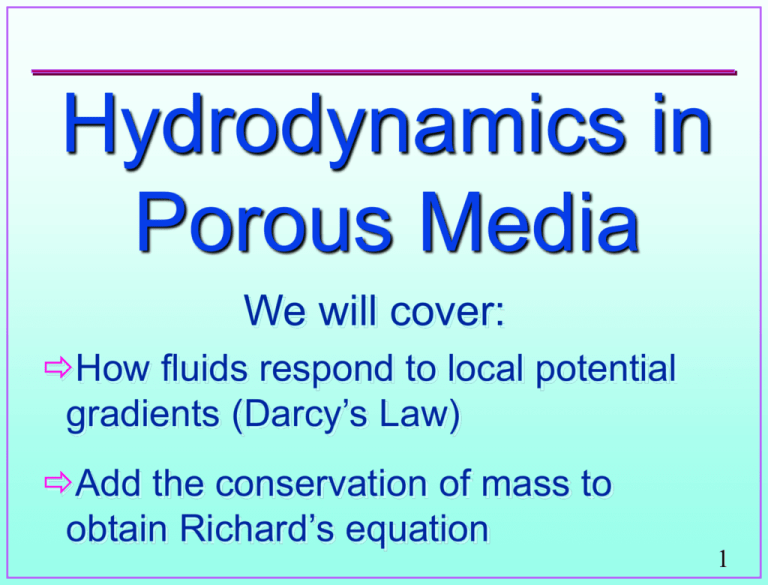
Hydrodynamics in Porous Media We will cover: How fluids respond to local potential gradients (Darcy’s Law) Add the conservation of mass to obtain Richard’s equation 1 Darcy’s Law for saturated media In 1856 Darcy hired to figure out the water supply to the town’s central fountain. Experimentally found that flux of water porous media could be expressed as the product of the resistance to flow which characterized the media, and forces acting to “push” the fluid through the media. Q - The rate of flow (L3/T) as the volume of water passed through a column per unit time. hi - The fluid potential in the media at position i, measured in standing head equivalent. Under saturated conditions this is composed of gravitational potential (elevation), and static pressure potential (L: force per unit area divided by g). K - The hydraulic conductivity of the media. The proportionality between specific flux and imposed gradient for a given medium (L/T). L - The length of media through which flow passes (L). A - The cross-sectional area of the column (L2). 2 Darcy’s Law Darcy then observed that the flow of water in a vertical column was well described by the equation A (H1 - H 0 ) Q= K L [2.68] Darcy’s expression is written in a general form for isotropic media as q = -K H [2.69] q is the specific flux vector (L/T; volume of water per unit area per unit time), K is the saturated hydraulic conductivity tensor (second rank) of the media (L/T), and H is the gradient in hydraulic head (dimensionless) 3 Aside on calculus ... What is this up-side-down triangle all about? The “dell” operator: short hand for 3-d derivative i, j, k x y z The result of “operating” on a scalar function (like potential) with is the slope of the function F points directly towards the steepest direction of up hill with a length proportional to the slope of the hill. Later we’ll use •F. The dot just tells us to take the dell and calculate the dot product of that and the function F (which needs to be a vector for this to make sense). “dell-dot-F” is the “divergence” of F. If F were local flux (with magnitude and direction), •F would be the amount of water leaving the point x,y,z. This is a scalar result! F takes a scalar function F and gives a vector slope •F uses a vector function F and gives a scalar result. 4 Now, about those parameters... Gradient in head is dimensionless, being length per length H1 H0 H = [2.70] L Q = Aq Q has units volume per unit time Specific flux, q, has units of length per time, or velocity. For vertical flow: speed at which the height of a pond of fluid would drop CAREFUL: q is not the velocity of particles of water The specific flux is a vector (magnitude and direction). Potential expressed as the height of a column of water, has units of length. 5 About those vectors... q = -KH [2.70] Is the right side of Darcy’s law indeed a vector? h is a scalar, but H is a vector Since K is a tensor (yikes), KH is a vector So all is well on the right hand side Notes on K: we could also obtain a vector on the right hand side by selecting K to be a scalar, which is often done (i.e., assuming that conductivity is independent of direction). 6 A few words about the K tensor q==- K xx K xy K xz h K yx K yy K yz x K zx K zy K zz h y h z K h +K h + K h ; K h +K h + K h ; K h +K h + K h xz yx yy yz zx zy zz z x y z x y z xx x xy y flux in x-direction flux in y-direction flux in z-direction Kab relates gradients in potential in the b-direction to flux that results in the a-direction. In anisotropic media, gradients not aligned with bedding give flux not parallel with potential gradients. If the coordinate system is aligned with directions of anisotropy the "off diagonal” terms will be zero (i.e., Kab=0 where ab). If, in addition, these are all equal, then the tensor collapses to a scalar. The reason to use the tensor form is to capture the 7 effects of anisotropy. Looking holistically Check out the intuitively aspects of Darcy’s result. The rate of flow is: Directly related to the area of flow (e.g., put two columns in parallel and you get twice the flow); Inversely related to the length of flow (e.g., flow through twice the length with the same potential drop gives half the flux); Directly related to the potential energy drop across the system (e.g., double the energy expended to obtain twice the flow). The expression is patently linear; all properties scale linearly with changes in system forces and dimensions. 8 Why is Darcy Linear? Because non-turbulent? No. Far before turbulence, there will be large local accelerations: it is the lack of local acceleration which makes the relationship linear. Consider the Navier Stokes Equation for fluid flow. The x-component of flow in a velocity field with velocities u, v, and w in the x, y, and z (vertical) directions, may be written u u u u -1 P z + u + v + w = -g + u t x y z x x 9 Creeping flow u u u u z -1 P + u + v + w = -g + u t x y z x x Now impose the conditions needed for which Darcy’s Law “Creeping flow”; acceleration (du/dx) terms small compared to the viscous and gravitational terms u u u 0 [2.69] x y z Similarly changes in velocity with time are small u 0 t [2.70] P gz 2u so N-S is: x [2.71] Linear in gradient of hydraulic potential on left, proportional to velocity and viscosity on right (same as Darcy). Proof of Darcy’s Law? No! Shows that the creeping flow assumption is sufficient to obtain correct form. 10 Capillary tube model for flow Widely used model for flow through porous media is a group of cylindrical capillary tubes (e.g.,. Green and Ampt, 1911 and many more). Let’s derive the equation for steady flow through a capillary of radius ro Consider forces on cylindrical control volume shown F=0 [2.75] s s r V ro 0 Cyl indrical Control Volume 11 Force Balance on Control Volume s s r V ro 0 Cyl indrical Control Volume end pressures: at S = 0 F1 = Pr2 at S = S F2 = (P + S dP/dS) r2 shear force: Fs = 2rS where is the local shear stress Putting these in the force balance gives Pr2 - (P + S dP/dS) r2 - 2rS = 0 [2.76] where we remember that dP/dS is negative in sign (pressure drops along the direction of flow) 12 continuing the force balance Pr2 - (P + S dP/dS) r2 - 2rS = 0 [2.76] With some algebra, this simplifies to =- r dP 2 dS [2.77] dP/dS is constant: shear stress varies linearly with radius dv From the definition of viscosity dr [2.78] Using this [2.77] says Multiply both sides by dr, and integrate v v ( r ) dv = v 0 r dP = 2 dS [2.79] r dP r ro 2 dS dr [2.80] dv dr r 13 Computing the flux through the pipe... Carrying out the integration we find v(r) = (r2-r02) dP 4 dS [2.81] which gives the velocity profile in a cylindrical pipe To calculate the flux integrate over the area Q = vdA [2.82] Area in cylindrical coordinates, dA = r d dr, thus Q= = r = r0 r 2 - r 0 2 d P r dr d dS 4 [2 .8 0 ] r = 0 14 Rearranging terms... The integral is easy to compute, giving r04 dP Q = - 8 dS [2.84] (fourth power!!) which is the well known Hagen-Poiseuille Equation. We are interested in the flow per unit area (flux), for which we use the symbol q = Q/r2 1 r02 dP q= - 8 dS [2.85] (second power) We commonly measure pressure in terms of hydraulic head, so we may substitute gh = P, to obtain r02 dh q= - 8 dS [2.86] 15 r 02 d h q= 8 dS [2 .8 3 ] r02/8 is a geometric term: function of the media. referred to as the intrinsic permeability, denoted by . is a function of the fluid alone NOTICE: Recovered Darcy’s law! See why by pulling out of the hydraulic conductivity we obtain an intrinsic property of the solid which can be applied to a range of fluids. SO if K is the saturated hydraulic conductivity, K= . This way we can calculate the effective conductivity for any fluid. This is very useful when dealing with oil spills ... boiling water spills ..... etc. 16 Darcy's Law at Re# > 1 Often noted that Darcy's Law breaks down at Re# > 1. Laminar flow holds capillaries for Re < 2000; HagenPoiseuille law still valid Why does Darcy's law break down so soon? Laminar ends for natural media at Re#>100 due to the tortuosity of the flow paths (see Bear, 1972, pg 178). Still far above the value required for the break down of Darcy's law. Real Reason: due to forces in acceleration of fluids passing particles at the microscopic level being as large as viscous forces: increased resistance to flow, so flux responds less to applied pressure gradients. 17 A few more words about Re#>1 Can get a feel for this through a simple calculation of the relative magnitudes of the viscous and inertial forces. FI Fv when Re# 10. Since FI go with v2, while Fv goes with v, at Re# 1 FI Fv/10, a reasonable cut-off for creeping flow approximation Isometric View d2 d1 d1 d2 Flow Cross-Section v1 v2 18 La w Deviations from Darcy’s law (a) The effect of inertial terms becoming significant at Re>1. Da rcy 's Re=100 1 K Re=10 (a) q Re=1 Re=0 h 10 100 Da rcy 's (b) At very low flow there may be a threshold gradient required to be overcome before any flow occurs at all due to hydrogen bonding of water. 1 La w 0 1 (b) K q 0 0 Threshold Press ure h 19 How does this apply to Vadose? Consider typical water flow where v and d are maximized Gravity driven flow near saturation in a coarse media. maximum neck diameter will be about 1 mm, vertical flux may be as high as 1 cm/min (14 meters/day). R = d 1 = 0.167 v1 = 1 gr/cm [2.100] 3 x 0.1 cm x 1 cm/min 0.01 gr/cm-sec [2.101] Typically Darcy's OK for vadose zone. Can have problems around wells 20 What about Soil Vapor Extraction? Does Darcy's law apply? Air velocities can exceed 30 m/day (0.035 cm/sec). The Reynolds number for this air flow rate in the coarse soil used in the example considered above is R= = d 1 v1 0.001 gr/cm = 0.02 3 x 0.1 cm x 0.035 cm/sec -4 gr/cm-sec 1.8 x 10 [2.101] [2.102] again, no problem, although flow could be higher than the average bulk flow about inlets and outlets 21 Summary of Darcy and Poiseuille For SATURATED MEDIA Flow is linear with permeability and gradient in potential (driving force) At high flow rates becomes non-linear due to local acceleration Permeability is due to geometric properties of the media (intrinsic permeability) and fluid properties (viscosity and specific density) Permeability drops with the square of pore size Assumed no slip solid-liquid boundary: doesn't work with gas. 22
